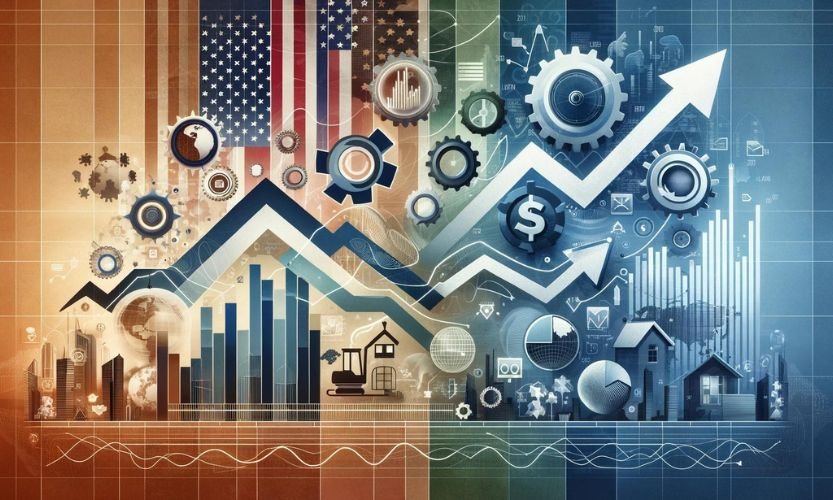Understanding Economic Indicators in Forex
FxNews – Forex trading involves understanding the world’s economy. Economic indicators give traders clues about a country’s financial health. This affects the value of its currency. These indicators fall into two types: leading indicators, which forecast future economic activities, and lagging indicators, which show trends after they happen.
The Rold of Leading Indicators in Economics

Indicators like the PMI, consumer sentiment surveys, and housing authorizations provide insights into future economic trends. A climbing PMI, for instance, suggests a boost in financial robustness, possibly leading to a more robust national currency. Forex traders often utilize these insights to predict upward market trends.
Examples of Leading indicators

PMI and economic activity: Exploring the link between PMI and the economy, a rising Purchasing Managers’ Index often reflects growth in manufacturing and services. This growth usually indicates a robust economy, potentially strengthening the national currency. For instance, an upward trend in the U.S. PMI could signal a rise in the dollar’s value.
Consumer confidence and spending patterns: In terms of consumer sentiment, a strong consumer confidence index or CCI often means people are optimistic about their financial prospects and more willing to spend. This spending can fuel economic expansion and boost the value of the national currency. A case in point is the Eurozone, where high consumer confidence could lead to a stronger Euro.
Housing permits as an economic indicator: Regarding housing permits, an uptick in these permits denotes a booming housing market, a favorable economic sign. This boom can heighten demand for the domestic currency, as the housing sector usually operates in the local currency.
For example, increasing Canadian housing permits might prompt forex traders to buy Canadian dollars, betting on their increased value.
Forex traders leverage these economic indicators to forecast currency trends and shape their trading strategies.
Lagging Indicators: Confirming the Trend
lagging indicators such as GDP data, unemployment figures, and consumer price indexes serve to validate current economic trends. For instance, a GDP report indicating significant growth typically signals a positive trend for a country’s currency. However, as these are lagging indicators, their impact might already be reflected in market prices when released.
Examples of Lagging Indicators
GDP Reports and Currency Value: Consider the effect of GDP growth on currency valuation. When a nation’s GDP report reveals substantial economic growth, it usually bodes well for its currency, indicating a thriving economy. For example, if the U.S. announces higher-than-expected GDP growth, it often signals a favorable outlook for the dollar. However, as GDP data comes out post-event, traders may have predicted this growth, reflecting it in the dollar’s value beforehand.
Unemployment Rates as a Market Indicator: Unemployment rates are economic indicators. A drop in a country’s unemployment rate typically signifies economic strengthening.
Say Germany reports a notable unemployment decrease; this would likely positively impact the Euro. Yet, since unemployment data is retrospective, the market might have already accounted for this in the Euro’s value, possibly influenced by earlier indicators like job postings or corporate hiring trends.
Consumer Price Index (CPI) and Inflation Trends: Regarding the Consumer Price Index (CPI) and inflation, an escalating CPI points to rising inflation, affecting the nation’s currency.
If Japan’s CPI climbs steadily, it might indicate inflation that could influence the Yen. However, the market might have prevented these inflationary trends through earlier indicators like fluctuating commodity prices or changes in retail sales.
In all these cases, while these lagging indicators confirm economic directions, their market impact and effect on currency values might be diminished. This reduction happens because their revelations are often anticipated and factored into market actions in advance.
Differences Between Leading and Lagging Indicators

Leading indicators are an advanced alert system offering early clues about the economy’s direction. These indicators shift before broader economic changes occur, providing a glimpse into future financial performance. This makes them essential tools for forecasting, enabling businesses, investors, and government officials to brace for what lies ahead.
On the other hand, lagging indicators are more like hindsight lenses. They provide clarity on economic trends but only after these trends have unfolded. These indicators shift in response to the economic events they represent, thus confirming established patterns and trends. They play a critical role in analyzing and understanding the factors that shape economic outcomes.
Interpreting Data Difference: Expectations & Reality
Differences between expected and actual economic data releases can lead to significant volatility. If the non-farm payroll report significantly deviates from expectations, it can cause sudden movements in the USD pairs. Traders must be good at quickly interpreting these variances to adjust their strategies accordingly.
Examples and Case Studies: Imagine a situation where the U.S. Federal Reserve unexpectedly raises interest rates. This action typically causes the U.S. dollar to rise, drawing international investments. A savvy forex trader, predicting this using key indicators, might profit by betting on the dollar’s strength against other currencies.
In a similar vein, consider the U.K. releasing its inflation statistics. Should these numbers exceed predictions, it might indicate an excessively robust economy. This scenario often leads to interest rate increases by the Bank of England, potentially boosting the British pound’s value.
Conclusion: Adapting to Forex Market Dynamics
Professional forex traders rely on economic indicators as a lantern through the dark hole of market forecasting. Utilizing these crucial economic indicators and mixing them wisely with risk management empowers traders to make informed decisions. To manage their positions, traders must stay updated with the latest market dynamics and economic shifts.
In this article, my effort is to shed light on parts of the market analysis that traders might have missed. Especially if you are new to the market, you must be fully aware of the elements that drive the market up or down.

J.J Edwards is a finance expert with 15+ years in forex, hedge funds, trading systems, and market analysis.



